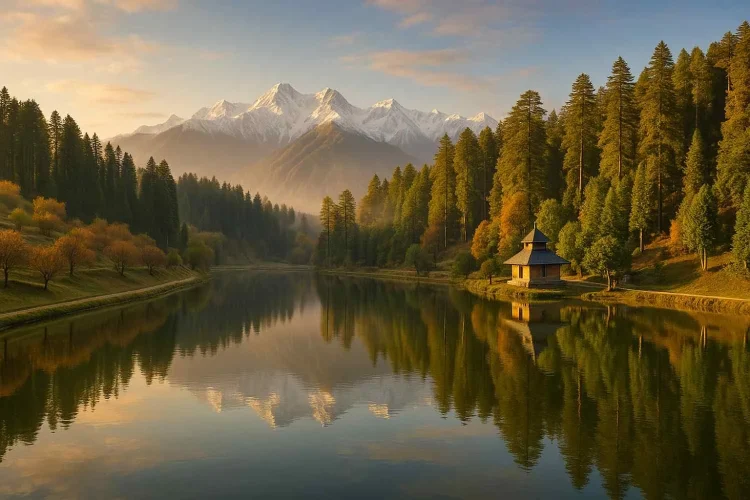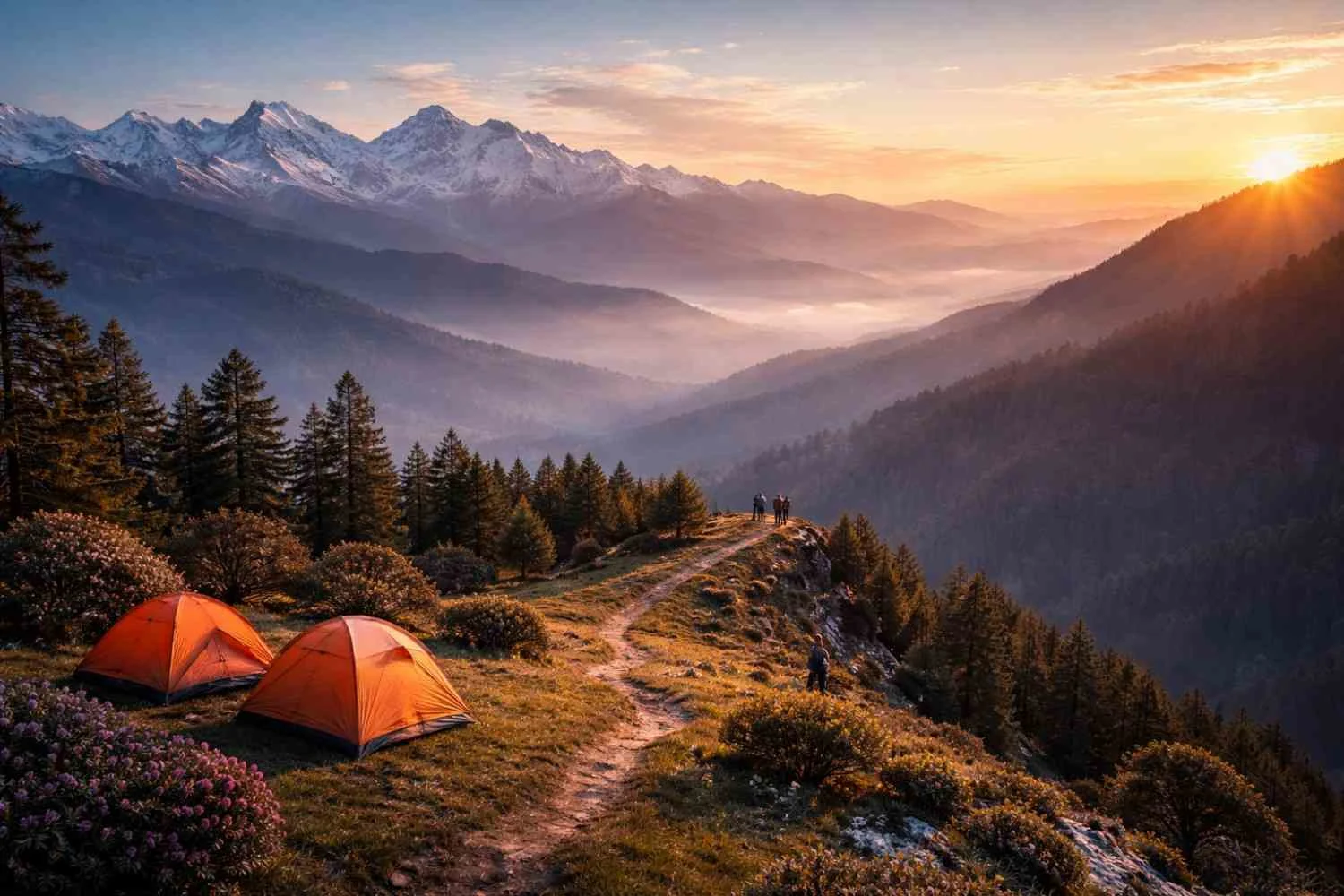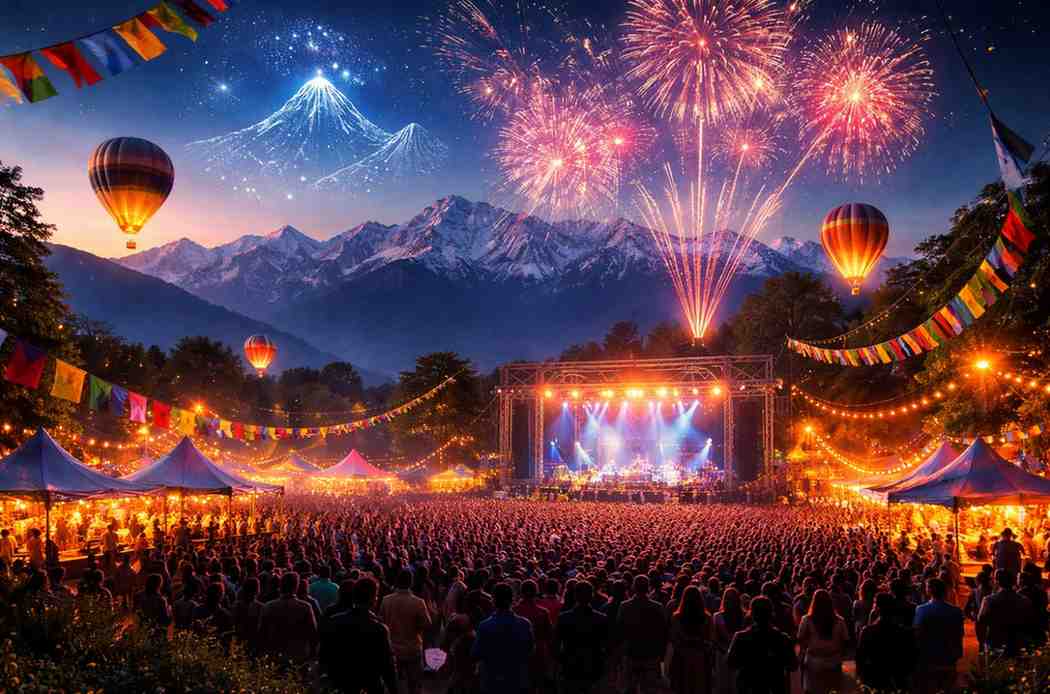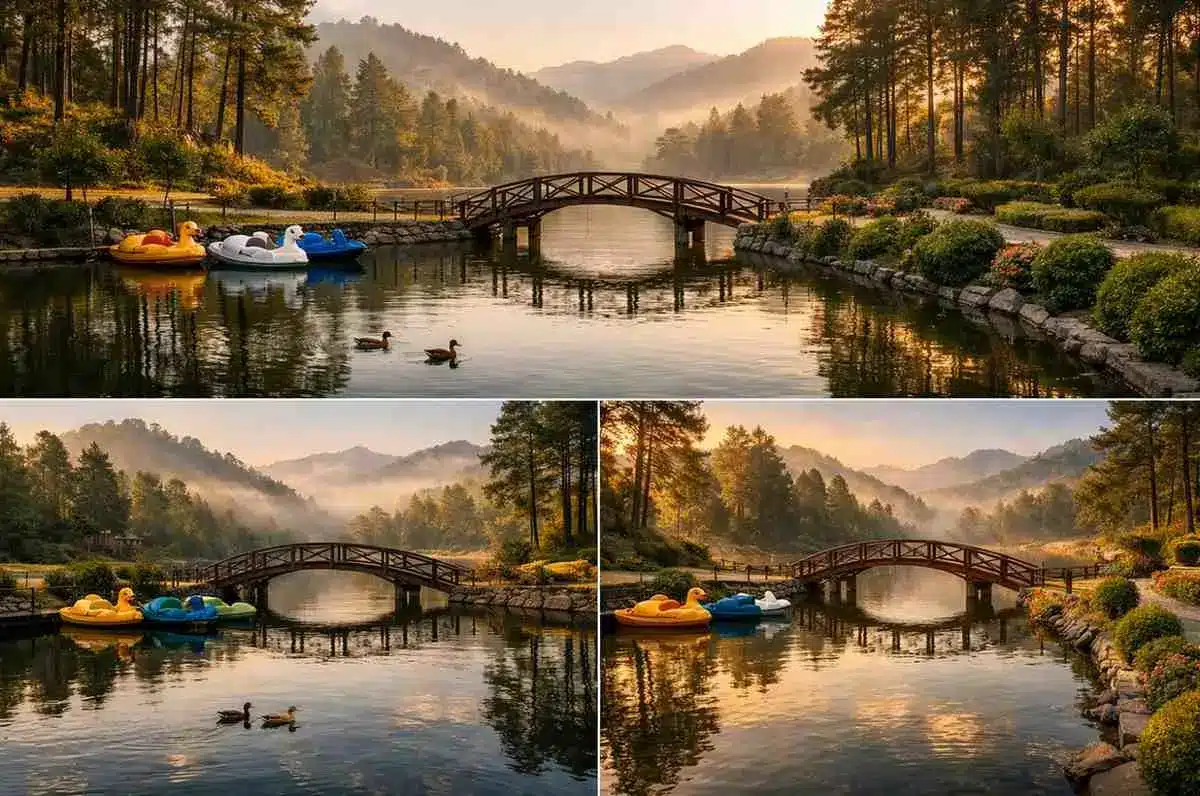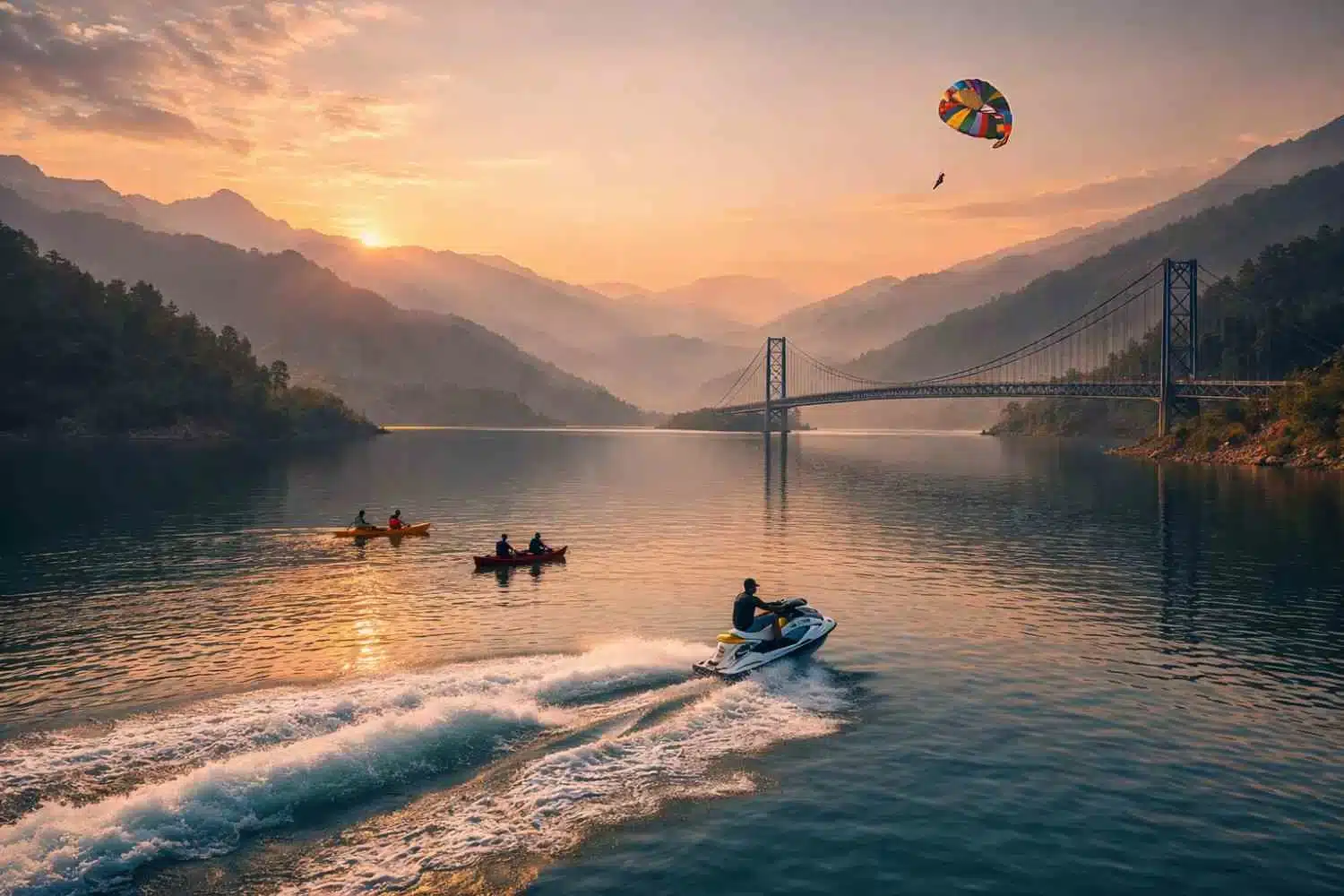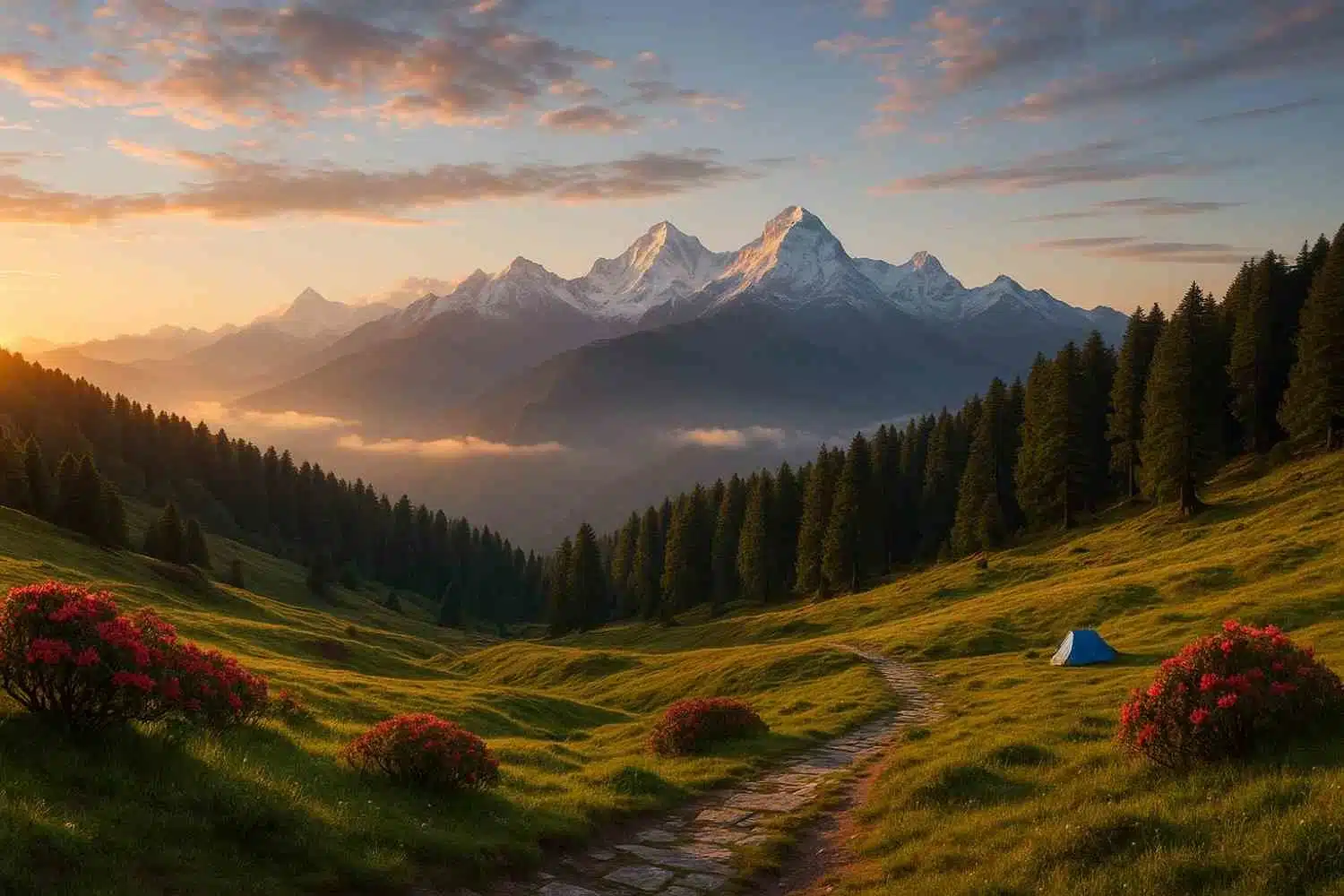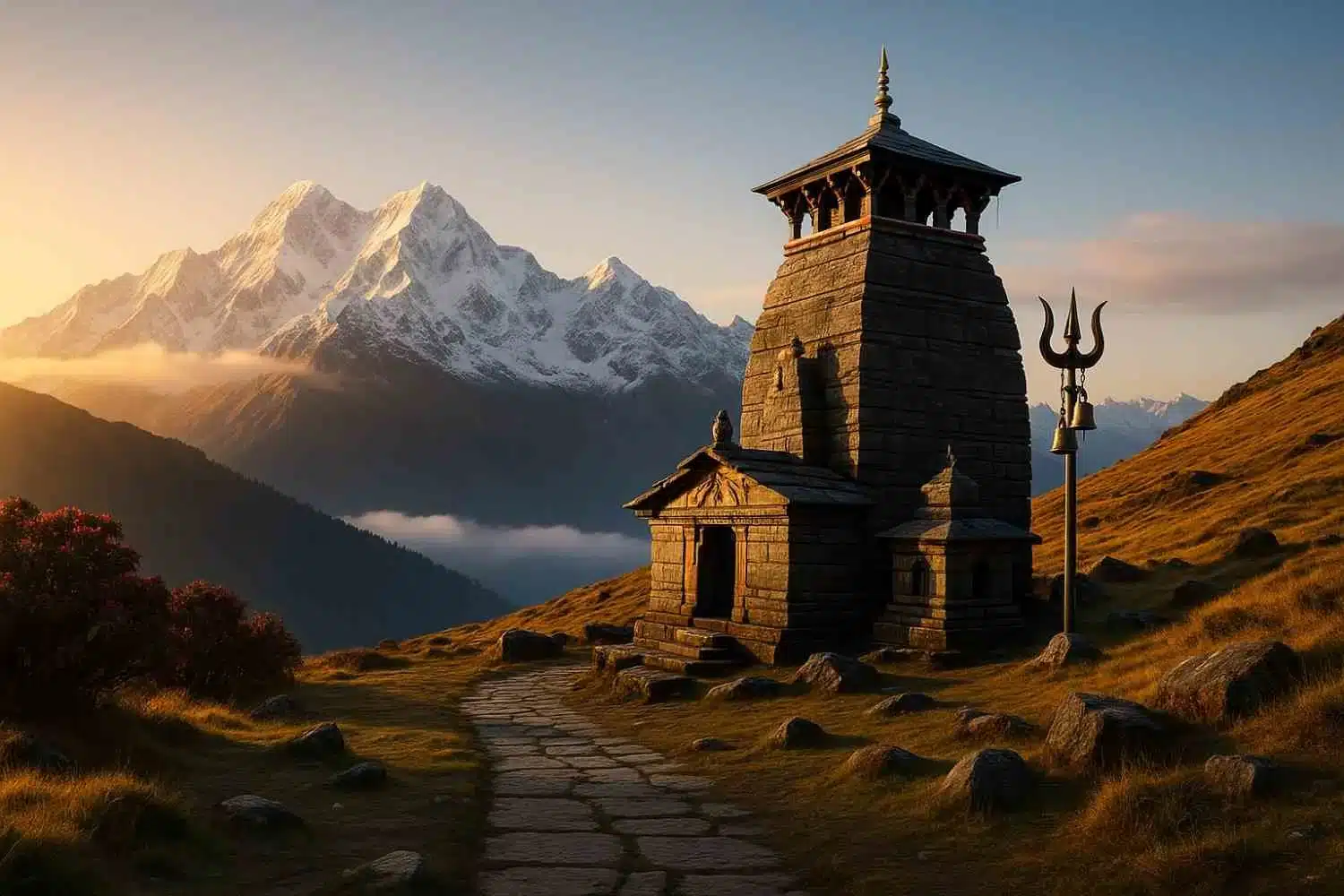Tani Jubbar Lake is one of those Himalayan hideaways that feels tailor-made for slow travel. Set a few kilometers off the main Shimla–Narkanda road, this small, sacred, oval-shaped lake rests at approximately 2,500 meters (8,200+ ft), enveloping you in the hush of deodar (cedar) and pine forests. The water often mirrors a ring of conifers and the changing sky, creating a living canvas that shifts hour by hour.
Locally revered, the lake is associated with Nag Devta (the Serpent Deity), a guardian spirit in many Himachali communities. Beside the lake sits a modest Nag Devta Temple, where villagers come to pray, celebrate, and give thanks for bountiful harvests—especially apples, which define much of the area’s economy and landscape. On any given day, you might see locals stopping to pay respects, families sharing a quiet picnic, or travelers taking a contemplative stroll along the water’s edge.
Despite its small size, Tani Jubbar Lake holds an outsized place in the hearts of people from Narkanda, Thanedar, and the surrounding valleys. For visitors, it’s an easy add-on to a Shimla–Narkanda itinerary: a pocket of calm in the middle of winding mountain roads, misty woods, and crisp air. Photographers love its symmetry and reflections; birders enjoy the treeline chorus; and anyone who’s been caught in the bustle of city life will gladly trade an hour (or more) to sit here and simply breathe.
Highlights at a glance:
- A small, sacred lake about 5 km from Narkanda town
- Nag Devta Temple on the lakeside
- Surrounded by dense deodar and pine forests, with apple orchards nearby
Popular for picnics, easy nature walks, and reflection photography
Jubbar Lake Narkanda Location & How to Reach
Where it is: Tani Jubbar Lake is tucked off the main highway near Narkanda, in the Shimla district of Himachal Pradesh. It’s an easy detour from NH5, making it one of the most accessible forest-ringed lakes in the region.
| From | Distance | Route |
| Shimla | ~65 km | NH5 → Narkanda → Tani Jubbar Road |
| Narkanda | ~5 km | Short drive or relaxed walk via apple orchards |
| Nearest Airport | Jubbarhatti, Shimla (~85 km) | Mountain airport; flights vary seasonally |
| Nearest Railway Station | Shimla (~70 km) | Narrow-gauge (Kalka–Shimla) connects to broad-gauge at Kalka |
By road from Shimla:
Follow NH5 toward Theog, Matiana, and Narkanda. Just before/after Narkanda (depending on your approach), a local road branches toward Tani Jubbar. The final stretch is a narrow, motorable road through orchards and tall deodars.
From Narkanda town:
Hire a local cab for a quick hop, drive your own vehicle, or enjoy a leisurely 5 km walk through orchards (seasonal blossoms in spring, fruiting in late summer/early autumn). The walk itself is part of the charm.
Tips for the last mile:
- Roads can be misty and damp; drive unhurriedly.
- In winter, snowfall is common; check local conditions and consider a 4×4 or chains when snow is fresh.
Parking is usually informal; be mindful not to block local access or temple pathways.
Jubbar Lake Narkanda Natural Beauty & Surroundings
There’s a quiet magnetism to Tani Jubbar Lake. The surface, often glassy in the morning, picks up reflections of snow-dusted ridgelines in winter and emerald conifers the rest of the year. A fringe of deodar and pine creates a natural amphitheater, softening sounds until you hear little beyond wind, birds, and the occasional temple bell.
What nature lovers will enjoy:
- Reflection photography: Early mornings and still evenings produce mirror-calm water. A tripod and a low angle near the bank can yield postcard-worthy symmetry.
- Nature walks: The trail around the lake is gentle. Extend your stroll into nearby woods for birdsong and the resinous scent of conifers.
- Birdwatching: Expect a mix of Himalayan forest species; patience rewards you with calls and quick flashes among the branches.
- Apple blossom season: Spring paints orchards in pale pink and white. If you love macro photography, blossoms plus morning dew equal magic.
- Monsoon lushness: July–September drapes the hills in intense greens. Mist lingers in the treetops, and the lake takes on deeper hues.
If you’re a landscape photographer, think in layers: foreground reeds or stones, the reflective lake as mid-ground, and the treeline or distant peaks as backdrop. A circular polarizer can help manage glare and saturate foliage when the sun is higher, but consider removing it during blue hour to preserve reflections.
Jubbar Lake Narkanda Cultural & Religious Significance
Tani Jubbar Lake is not only scenic; it’s sacred. The waters are closely tied to the worship of Nag Devta, a protective deity widely revered across Himachal’s mid-Himalayan belt. The nearby Nag Devta Temple—simple, wooden, and steeped in local tradition—anchors the lake’s spiritual identity.
What to know about the cultural layer:
- Local reverence: Villagers treat the lake and temple precinct with respect. Visitors are welcome, but quiet behavior and modest attire are appreciated.
- Offerings & customs: On special days, locals carry offerings of flowers, incense, and traditional foods. If you choose to offer, follow what locals do and avoid plastic packaging.
- Community fair: Each year, the Tani Jubbar Fair brings together nearby villages for folk dance, music, seasonal foods, and traditional rituals honoring Nag Devta. Dates can shift year to year, but the spirit—gratitude for nature and community—remains constant.
By visiting mindfully, you become part of a living cultural landscape rather than a passerby. Ask before photographing people, step aside for processions, and avoid loud music. The lake’s serenity is both natural and communal.
Best Time to Visit Jubbar Lake Narkanda
Himachal’s mid-Himalayan climate gives each season a distinct personality. Pick the time that matches your vibe
| Season | Experience |
| April–June | Clear skies, pleasant days, cool nights; apple blossoms in surrounding orchards. |
| October–November | Golden light, autumn colors, crisp views; quieter after the monsoon. |
| December–February | Cold, with chances of snow; forests turn ethereal under fresh powder. |
| July–September | Lush greenery, moody mists; carry rain protection and tread carefully. |
Photographer’s note:
- Late April–May: Blossom portraits and pastel reflections.
- Post-monsoon (Oct): Hyper-clear skies for long-range mountain views.
- Winter: Snow scenes with deep contrasts; plan for cold gear and earlier sunsets.
Things to Do at Tani Jubbar Lake
Tani Jubbar Lake rewards slow, simple pleasures. If your itinerary is tight, even 30–45 minutes can feel restorative. If you have more time, lean into unhurried exploration.
- Lakeside picnic: Pack a light spread—local breads, fruit, and a thermos of chai. Carry back all waste; the lake is sacred, and there are limited bins.
- Visit the Nag Devta Temple: Observe a few quiet minutes; if a caretaker is present, a small donation helps upkeep. Remove shoes before stepping onto temple platforms.
- Explore apple orchards: Depending on season, you’ll find blossoms or fruiting trees. Buy apples or local produce directly from growers if available.
- Short treks: Use the lake as a mellow warm-up before heading to Hatu Peak, which offers sweeping Himalaya views from about 3,400 m (11,000 ft).
- Birding and nature journaling: Bring binoculars or a sketchbook. The setting invites observation.
- Mindful breaks: Try guided breathing or a few minutes of meditation by the water. The tree cover and stillness make it easy to unwind.
“Sit on the stone ledge, close your eyes, and count your breath. The forest does the rest.”
Tani Jubbar Lake Nearby Attractions
Tani Jubbar Lake fits beautifully into a broader Narkanda circuit. You can combine it with high-altitude viewpoints, heritage farms, and small temples:
- Hatu Peak & Hatu Mata Temple: A signature Narkanda experience with panoramic views. Roads are narrow; drive early and avoid weekends/holidays for lighter traffic.
- Narkanda Market & Apple Valley: Sample local snacks, buy seasonal apples, and chat with residents about orchard life.
- Stokes Farm (Kotgarh): The region where American missionary Satyanand Stokes helped popularize apple cultivation—a cornerstone of the local economy.
- Thanedar & Mahamaya Temple: Quiet villages, ridge-top vistas, and old-world orchards—wonderful for unhurried drives and photo stops.
Trip idea (1 day from Shimla):
Shimla → Narkanda (breakfast) → Tani Jubbar Lake (mid-morning walk & tea) → Hatu Peak (noon) → Late lunch in Narkanda → Apple stops in Kotgarh/Thanedar → Return to Shimla.
Trip idea (overnight in Narkanda):
Day 1: Shimla → Tani Jubbar Lake → Narkanda stroll & sunset.
Day 2: Sunrise at Hatu Peak → brunch in town → orchard visit → leisurely return.
Tani Jubbar Lake Travel Tips for Visitors
Weather & clothing
- Even in summer, carry a light woolen/fleece—mountain weather flips quickly.
- In winter, pack thermals, gloves, and good footwear; snow can linger in shaded stretches.
- Monsoon travelers should bring a compact rain jacket and quick-dry layers.
Etiquette & sustainability
- Do not litter. Pack reusable bottles and snack boxes; carry a small trash bag.
- Respect the temple: remove shoes where required, dress modestly, and keep voices low.
- No swimming/boating: The lake is sacred; treat the water with reverence.
- Drone caution: If flying a drone, check local rules and avoid temple hours or gatherings.
Logistics & safety
- Snacks/Water: Limited eateries near the lake. Stock up in Narkanda.
- Parking: Park without obstructing paths or the temple entrance.
- Mobile network: Coverage can be patchy; download maps offline.
- Health: At ~2,500 m, most travelers feel fine, but walk at an easy pace if you’ve just arrived from the plains.
- Children & seniors: The terrain around the lake is gentle; keep an eye on footing near water.
Photography tips
- Golden hours (sunrise/sunset) for reflections and warm tones.
- Use a polarizer sparingly to balance glare vs. reflections.
- Tripod helps for low-light forest scenes and silky water edges.
- Respect privacy: Ask before photographing people; avoid disturbing prayer.
Tani Jubbar Lake Responsible Travel & Local Economy
Tani Jubbar Lake sits within communities that rely on orchards, small shops, and seasonal tourism. Your choices can keep this place pristine:
- Buy local produce: Apples, apricots, seasonal pickles, and jams—look for homestyle labels.
- Choose homestays or small lodges in/around Narkanda to spread benefits within the community.
- Hire local cabs/guides when possible—especially helpful in winter or on Hatu Peak roads.
- Refill, not landfill: Carry a bottle and ask cafes to refill. Many are happy to help if you ask politely.
Tani Jubbar Lake Suggested 1–2 Day Itineraries
1. Half-Day Add-On (from Narkanda):
- Early breakfast → Tani Jubbar Lake stroll & temple visit → photo session along the lakeshore → chai break → return to town for lunch.
2. Full Day Scenic Sampler:
- Shimla → Narkanda → Tani Jubbar Lake (mid-morning) → Hatu Peak (noon to afternoon) → late apple valley drive through Thanedar/Kotgarh → Shimla.
3. Slow Travel Overnight:
- Day 1: Shimla → orchard walk → Tani Jubbar Lake picnic → sunset at Narkanda Ridge.
- Day 2: Hatu Peak sunrise → relaxed brunch → village amble and produce shopping → return.
Tani Jubbar Lake Packing List (Season-Smart)
- Year-round: Reusable bottle, sun cap, sunglasses, sunscreen, lip balm, basic first aid, light fleece, power bank, small trash bag.
- Monsoon (Jul–Sep): Rain jacket/poncho, water-resistant shoes, quick-dry layers, dry bag for electronics.
- Winter (Dec–Feb): Thermals, insulated jacket, beanie, gloves, warm socks, grippy footwear (microspikes if you expect icy paths).
- Photographers: Tripod, extra batteries (cold drains them fast), microfiber cloth, polarizer/ND as needed.
Where to Stay & Eat Near Tani Jubbar Lake (General Pointers)
- Stay: Narkanda offers a mix of homestays, guesthouses, and small hotels. Booking ahead in peak blossom (spring) and snow (winter) windows is wise.
- Eat: Simple mountain cafes and dhabas serve parathas, rajma-chawal, momos, noodles, and seasonal specials. If you’re vegetarian, you’ll do well; non-veg options exist too.
- Coffee/Tea stops: Plenty along NH5; choose ones with parking off the highway.
(Note: Specific hotel/restaurant names change frequently; check current reviews or ask your host in Narkanda for the latest.)
Tani Jubbar Lake Photography & Mindfulness Walk: A Mini Route
- Start: Small clearing near the lakeside approach road. Take five deep breaths to settle.
- Clockwise loop: Hug the shoreline, pausing wherever reeds or stones create foreground interest.
- Temple pause: Step quietly to the Nag Devta Temple. If devotees are present, wait your turn and keep your cameras respectful.
- Forest edge: Move a little into the deodars; look for leading lines—paths, fallen logs, low branches.
- Return view: Finish where you began and photograph the full oval of the lake, capturing both treeline and sky.
Time required: 30–60 minutes (or longer if you journal or sketch).
Tani Jubbar Lake Practical Do’s & Don’ts
Do:
- Greet locals; a simple “Namaste” goes a long way.
- Keep music low or use headphones.
- Support local crafts and produce.
- Check the weather before you set out.
Don’t:
- Litter or leave food scraps (they attract animals).
- Enter the water (it’s sacred).
- Fly drones over the temple or during rituals.
- Block narrow roads while parking.
Conclusion
Tucked among deodars and apple slopes, Tani Jubbar Lake, Narkanda, Himachal Pradesh, is a gentle masterpiece—small enough to feel intimate, yet expansive in the way it calms your senses. It blends natural charm, cultural heritage, and a quiet spiritual thread that’s become rare in busier hill circuits. Whether you come for a brief pause on a Shimla–Narkanda road trip or weave it into a slow, orchard-dotted itinerary, the lake will likely become the moment you remember most: still water, clean air, and the easy rhythm of mountain life.
For travelers who crave serenity, respectful cultural encounters, and scenery that rewards patience, Tani Jubbar is a must-visit. Bring a light jacket, a camera, and an open heart—leave with lighter thoughts and a heavier photo roll.
FAQs
Where is Tashi Jong Monastery located?
In Tashi Jong village, near Palampur, Kangra District, Himachal Pradesh, India.
How far is Tashi Jong Monastery from Palampur and Dharamshala?
About 15 km from Palampur; roughly 60–65 km from Dharamshala (road-dependent).
What is the altitude of Tashi Jong Monastery?
Approximately 1,250–1,350 m above sea level (similar to Palampur’s elevation).
How can I reach Tashi Jong Monastery by road or train?
Road: Via NH-503 through Palampur/Baijnath; local turn-off to Tashi Jong.Train: Nearest major railhead is Pathankot (~120 km), then road transfer.
Is Tashi Jong Monastery open to visitors throughout the year?
Yes, year-round, subject to weather and monastery schedules.
What is the best way to reach Tashi Jong from Palampur?
Taxi is quickest; local buses also ply but are slower with more stops.
Does Tashi Jong Monastery charge any entry fee?
No, entry is generally free.
What are the visiting hours of Tashi Jong Monastery?
Typically 8 AM – 6 PM (confirm on arrival; prayer times may limit access to certain halls).
When was Tashi Jong Monastery established?
In the late 20th century.
Who founded Tashi Jong Monastery?
The Eighth Khamtrul Rinpoche is credited with its founding and guidance.
What is the historical significance of Tashi Jong Monastery?
It’s a key exile-era seat preserving Drukpa Kagyu teachings, arts, and community life.
Which Buddhist lineage or sect does Tashi Jong Monastery belong to?
Drukpa Kagyu (Kagyu tradition of Tibetan Buddhism).
What does the name “Tashi Jong” mean?
In Tibetan, “Tashi” implies auspicious, and “Jong” means fort/valley/seat—often read as “Auspicious Valley/Seat.”
What role does Tashi Jong play in Tibetan Buddhism?
It serves as a teaching, practice, and cultural center for the Drukpa Kagyu lineage.
Is Tashi Jong Monastery associated with Khamtrul Rinpoche?
Yes, it is a principal seat of the Khamtrul Rinpoche lineage
What is the architectural style of Tashi Jong Monastery?
Traditional Tibetan monastery style—tiered roofs, vivid colors, dharma symbols.
What makes the design of Tashi Jong Monastery unique?
Its harmonious setting with the Dhauladhar, intricate murals, and stupas accenting landscaped courtyards.
What can visitors see inside the monastery complex?
Prayer halls, murals, statues, chortens, prayer wheels, and quiet gardens.
Are there monks living at Tashi Jong Monastery?
Yes, it’s an active monastic community.
Does Tashi Jong have a prayer hall or meditation area open to tourists?
The main prayer hall is generally accessible to respectful visitors during open hours.
Are photography and videography allowed inside the monastery?
Outside—usually fine. Inside halls—ask permission; no flash and no disturbance.
What are the main festivals celebrated at Tashi Jong Monastery?
Losar (Tibetan New Year) and select Cham (masked dance) days, among other auspicious dates.
What cultural or religious events are held annually?
Ritual prayer ceremonies, teachings, and masked dances tied to the Tibetan lunar calendar.
What are the top things to do at Tashi Jong Monastery?
Observe prayers, explore the Khampagar complex, shop for crafts, and enjoy mountain vistas
How much time is needed to explore Tashi Jong Monastery?
1–2 hours comfortably; longer if you linger for prayers or photography.
Are guided tours available for visitors?
Formal tours are limited; ask on site—sometimes a monk or staff member may offer brief guidance.
Is there any dress code for entering the monastery?
Modest clothing covering shoulders and knees is recommended.
Are there restaurants or cafes near Tashi Jong Monastery?
Small local eateries/tea stalls may be nearby; broader options in Palampur.
What are the accommodation options near Tashi Jong?
Guesthouses and hotels in Palampur and Baijnath suit various budgets.
Is the monastery suitable for family visits?
Yes—peaceful and educational for families with respectful children.
Are toilets and basic facilities available for tourists?
Basic facilities are typically available; carry essentials and cash.
Which places can I visit near Tashi Jong Monastery?
Andretta, Baijnath Temple, Palampur Tea Gardens, Bir Billing.
How far is Tashi Jong from Andretta Artist Village?
Around 10 km.
Can I visit Baijnath Temple and Tashi Jong on the same day?
Yes—20 km apart, commonly combined.
Are there trekking routes or scenic spots near Tashi Jong?
The Kangra Valley offers gentle village walks, tea-garden strolls, and ridge viewpoints.
Is Tashi Jong close to Palampur Tea Gardens?
Yes—about 12 km.
How far is Bir Billing from Tashi Jong Monastery?
Roughly 35 km by road.
What is the best time to visit Tashi Jong Monastery?
March–June and Sep–Nov for clear views and festivals.
How is the weather in Tashi Jong throughout the year?
Pleasant spring, monsoon rains in July–Aug, clear autumn, chilly winters.
Is winter a good season to visit Tashi Jong?
Yes, if you enjoy quiet and crisp air; carry warm clothing.
When are the major festivals or prayer ceremonies held?
Around Losar and specific lunar dates; check locally for exact schedules.
What meditation or spiritual programs are offered at Tashi Jong?
Primarily monastic programs; short public teachings may occur—ask on arrival.
Can tourists participate in Buddhist prayers or rituals?
You may observe quietly; participation is limited and subject to monastery guidance.
Is there a monastery guesthouse for visitors?
Accommodation is generally external; inquire locally if any limited stays are allowed during events.
Are there any souvenir or handicraft shops inside Tashi Jong?
Yes—small craft shops often sell incense, prayer flags, art prints, and handmade items.
What rules should visitors follow at the monastery?
Silence, modest dress, no shoes in halls, no disruptive photos, and respect prayer times.
What is the daily routine of monks at Tashi Jong Monastery?
Morning/evening prayers, study, ritual practice, community chores, and personal meditation.
Is Tashi Jong Monastery eco-friendly or sustainable?
Practices tend to be low-impact, with traditional materials and careful resource use typical of monastic life.
Why is Tashi Jong Monastery famous among tourists and pilgrims?
For its serenity, authentic Tibetan culture, and Dhauladhar backdrop—a rare, unhurried atmosphere.
What is the distance between Tashi Jong and Kangra Airport?
Approximately 40 km.
How safe is Tashi Jong Monastery for solo travelers?
Generally safe; standard rural travel precautions apply.
What is the nearest bus stop or railway station to Tashi Jong?
Local buses connect via nearby villages/Palampur; major rail is Pathankot.
Can foreigners visit and stay near Tashi Jong Monastery?
Yes—foreigners can visit; stays are best arranged in Palampur/Baijnath.
What makes Tashi Jong Monastery a must-visit place in Himachal Pradesh?
Its living spiritual heritage, Tibetan artistry, and mountain calm—all within easy reach of Palampur.
